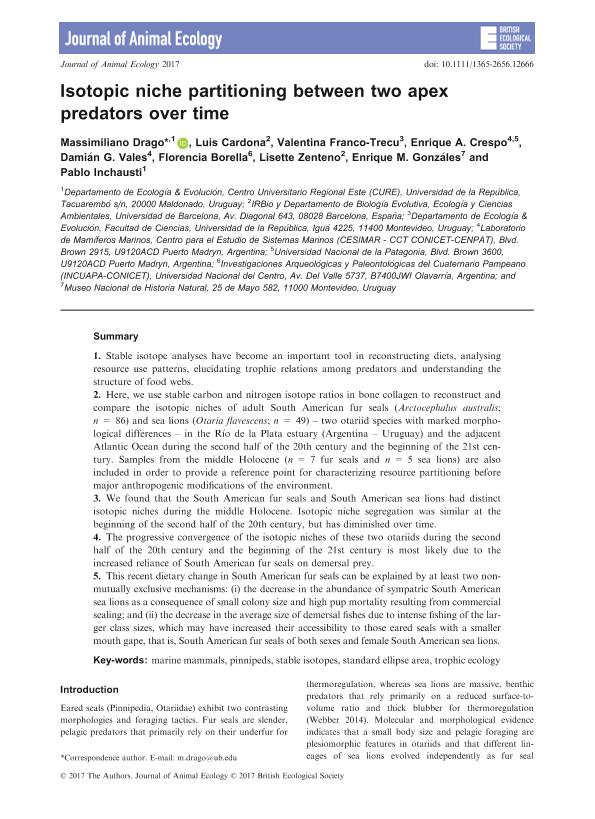Mostrar el registro sencillo del ítem
dc.contributor.author
Drago, Massimiliano
dc.contributor.author
Cardona, Luis
dc.contributor.author
Franco Trecu, Valentina
dc.contributor.author
Crespo, Enrique Alberto

dc.contributor.author
Vales, Damián Gustavo

dc.contributor.author
Borella, Florencia

dc.contributor.author
Zenteno, Lisette

dc.contributor.author
Gonzáles, Enrique M.
dc.contributor.author
Inchausti, Pablo
dc.date.available
2018-04-25T19:18:05Z
dc.date.issued
2017-03
dc.identifier.citation
Drago, Massimiliano; Cardona, Luis; Franco Trecu, Valentina; Crespo, Enrique Alberto; Vales, Damián Gustavo; et al.; Isotopic niche partitioning between two apex predators over time; Wiley Blackwell Publishing, Inc; Journal Of Animal Ecology; 86; 4; 3-2017; 1-15
dc.identifier.issn
0021-8790
dc.identifier.uri
http://hdl.handle.net/11336/43496
dc.description.abstract
1. Stable isotope analyses have become an important tool in reconstructing diets, analyzing resource use patterns, elucidating trophic relations among predators and understanding the structure of food webs.<br />2. Here, we use stable carbon and nitrogen isotope ratios in bone collagen to reconstruct and compare the isotopic niches of adult South American fur seals (Arctocephalus australis; n = 86) and sea lions (Otaria flavescens; n = 49) ?two otariid species with marked morphological differences? in the Río de la Plata estuary (Argentina - Uruguay) and the adjacent Atlantic Ocean during the second half of the 20th century and the beginning of the 21st century. Samples from the middle Holocene (n = 7 fur seals and n = 5 sea lions) are also included in order to provide a reference point for characterizing resource partitioning before major anthropogenic modifications of the environment.<br />3. We found that the South American fur seals and South American sea lions had distinct isotopic niches during the middle Holocene. Isotopic niche segregation was similar at the beginning of the second half of the 20th century, but has diminished over time.<br />4. The progressive convergence of the isotopic niches of these two otariids during the second half of the 20th century and the beginning of the 21st century is most likely due to the increased reliance of South American fur seals on demersal prey.<br />5. This recent dietary change of South American fur seals can be explained by at least two non-mutually exclusive mechanisms: (i) the decrease in the abundance of sympatric South American sea lions as a consequence of small colony size and high pup mortality resulting from commercial sealing; and (ii) the decrease in the average size of demersal fishes due to intense fishing of the larger class sizes, which may have increased their accessibility to those eared seals with a smaller mouth gape, i.e., South American fur seals of both sexes and female South American sea lions.
dc.format
application/pdf
dc.language.iso
eng
dc.publisher
Wiley Blackwell Publishing, Inc

dc.rights
info:eu-repo/semantics/openAccess
dc.rights.uri
https://creativecommons.org/licenses/by-nc-sa/2.5/ar/
dc.subject
Marine Mammals
dc.subject
Pinnipeds
dc.subject
Stable Isotopes
dc.subject
Standard Ellipse Area
dc.subject
Trophic Ecology
dc.subject.classification
Otras Ciencias Biológicas

dc.subject.classification
Ciencias Biológicas

dc.subject.classification
CIENCIAS NATURALES Y EXACTAS

dc.title
Isotopic niche partitioning between two apex predators over time
dc.type
info:eu-repo/semantics/article
dc.type
info:ar-repo/semantics/artículo
dc.type
info:eu-repo/semantics/publishedVersion
dc.date.updated
2018-04-05T18:21:33Z
dc.journal.volume
86
dc.journal.number
4
dc.journal.pagination
1-15
dc.journal.pais
Reino Unido

dc.journal.ciudad
Londres
dc.description.fil
Fil: Drago, Massimiliano. Universidad de la República; Uruguay
dc.description.fil
Fil: Cardona, Luis. Universidad de Barcelona; España
dc.description.fil
Fil: Franco Trecu, Valentina. Universidad de la República; Uruguay
dc.description.fil
Fil: Crespo, Enrique Alberto. Consejo Nacional de Investigaciones Científicas y Técnicas. Centro Científico Tecnológico Conicet - Centro Nacional Patagónico. Centro para el Estudio de Sistemas Marinos; Argentina
dc.description.fil
Fil: Vales, Damián Gustavo. Consejo Nacional de Investigaciones Científicas y Técnicas. Centro Científico Tecnológico Conicet - Centro Nacional Patagónico. Centro para el Estudio de Sistemas Marinos; Argentina
dc.description.fil
Fil: Borella, Florencia. Consejo Nacional de Investigaciones Científicas y Técnicas. Centro Científico Tecnológico Conicet - Tandil. Investigaciones Arqueológicas y Paleontológicas del Cuaternario Pampeano. Universidad Nacional del Centro de la Provincia de Buenos Aires. Investigaciones Arqueológicas y Paleontológicas del Cuaternario Pampeano; Argentina
dc.description.fil
Fil: Zenteno, Lisette. Universidad de Barcelona; España
dc.description.fil
Fil: Gonzáles, Enrique M.. Museo Nacional de Historia Natural; Uruguay
dc.description.fil
Fil: Inchausti, Pablo. Universidad de la República; Uruguay
dc.journal.title
Journal Of Animal Ecology

dc.relation.alternativeid
info:eu-repo/semantics/altIdentifier/doi/https://dx.doi.org/10.1111/1365-2656.12666
dc.relation.alternativeid
info:eu-repo/semantics/altIdentifier/url/https://besjournals.onlinelibrary.wiley.com/doi/abs/10.1111/1365-2656.12666
Archivos asociados
